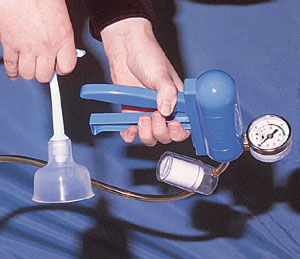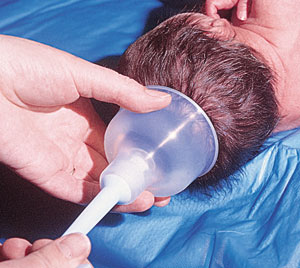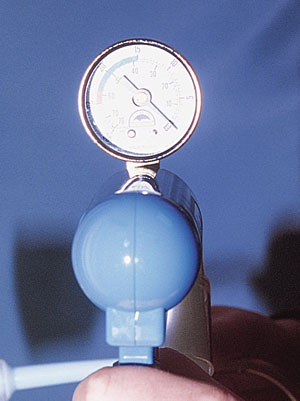
Am Fam Physician. 2000;62(6):1316-1320
Vacuum extractors have replaced forceps for many situations in which assistance is required to achieve vaginal delivery. Compared with metal-cup vacuum extractors, soft-cup devices are easier to use and cause fewer neonatal scalp injuries; however, they detach more frequently. Vacuum extractors can cause neonatal injury. These devices should be employed when indicated, usually for a nonreassuring fetal heart tracing or failure to progress in the second stage of labor. Complications may be minimized if the physician recognizes contraindications to the use of vacuum extraction. Complete documentation is essential.
When spontaneous vaginal delivery is not possible, instrumental delivery may be attempted. In 1705, Yonge described an attempted vaginal delivery using a cupping glass. In 1848, the developer of the Simpson forceps devised a bell-shaped device called an “air tractor vacuum extractor.” Multiple innovations followed, and a metal-cup extractor was developed by Malmström in 1953. More recently, bell-shaped and hemispheric silicone rubber cups have come into use.1 This article discusses the two basic types of vacuum extractors and their use in vaginal deliveries.
Types of Vacuum Extractors
METAL CUP
The metal-cup vacuum extractor is a mushroom-shaped metal cup varying from 40 to 60 mm in diameter. A centrally attached chain connects the cup to a detachable handle that is used to apply traction. A mechanical or electrical suction device is attached to the metal cup via a peripherally located vacuum port.
The advantages of metal-cup vacuum extraction over soft-cup extraction include a higher success rate and easier cup placement in the occipitoposterior (OP) position, especially when an OP cup is used.2 Unfortunately, the rigidity of metal cups can make application difficult and uncomfortable, and their use is associated with an increased risk of fetal scalp injuries.3 Metal-cup vacuum extractors are rarely used in the United States.
SOFT CUPS
Compared with metal-cup devices, soft-cup vacuum extractors cause fewer neonatal scalp injuries. However, these instruments have a higher failure rate.2
Soft-cup instruments can be used with a manual vacuum pump or an electrical suction device. Some have a built-in vacuum-release valve that allows pressure to be rapidly attained and accurately controlled. This results in easy maneuverability and simplicity of operation. Soft-cup vacuum extractors may be disposable or reusable.

Vacuum Extractors and Forceps
In Europe, the vacuum extractor has long been the instrument of choice for assisted vaginal delivery. In the United States, the forceps has been preferred, although the vacuum extractor is becoming increasingly popular.6
The advantages and disadvantages of vacuum extractors and forceps are listed in Table 1.4,7–11 A recent Cochrane review7 found that the risks and benefits of the two forms of assisted delivery are comparable. Often, the delivery instrument is selected based on the training and experience of the individual physician.
| Vacuum extractors |
| Easier to learn |
| Quicker delivery |
| Less maternal genital trauma |
| Less maternal discomfort |
| Fewer neonatal craniofacial injuries |
| Less anesthesia required |
| Forceps |
| Fewer neonatal injuries, including cephalohematoma, retinal hemorrhage and transient lateral rectus palsy |
| Higher rate of successful vaginal delivery |
Indications and Contraindications for Vacuum Extraction
The exact gestational age at which a fetus is considered too premature for vacuum-assisted delivery has been debated. Many authors8 use a gestational age of 34 weeks as the cutoff point. One review13 found no significant difference in neonatal morbidity rates following vacuum extraction of preterm infants (birth weights of 1,500 to 2,499 g [3 lb, 4 oz to 5 lb, 6 oz]) and full-term infants.
| Maternal indications |
| Need to avoid voluntary maternal expulsive efforts (e.g., the mother has cardiac or cerebrovascular disease) |
| Inadequate maternal expulsive efforts |
| Maternal exhaustion or lack of cooperation |
| Fetal indications |
| Nonreassuring fetal heart tracing |
| Prolonged second stage of labor |
| Failure to progress in second stage of labor |
| Fetal prematurity (< 34 weeks of gestation) |
| Fetal scalp trauma |
| Unengaged head |
| Incomplete cervical dilatation |
| Active bleeding or suspected fetal coagulation defects |
| Suspected macrosomia |
| Nonvertex presentation or other malpresentation |
| Cephalopelvic disproportion |
| Delivery requiring rotation or excessive traction |
| Inadequate anesthesia |
Some authors14 now consider vacuum-assisted deliveries to be possible before full cervical dilatation and at higher locations (stations) of the occiput in the birth canal.
The decision to proceed with a vacuum-assisted delivery when a relative contraindication exists must be based on a comparison of the risks of the vacuum-assisted delivery and the risks of other delivery options. In these situations, consultation is generally advisable.
Procedure Using Soft-Cup Vacuum Extraction
After the patient has emptied her bladder, she is placed in the dorsal lithotomy position without strapping or taping of her legs. Adequate anesthesia can be obtained with an epidural, spinal or pudendal block. The fetal presentation, position and station are then confirmed.
Avoiding undue stretch on the perineum, the physician applies the soft cup by spreading the patient's labia, compressing the cup and inserting it gently by pressing inward and downward with the inferior edge over the posterior fourchette.
When contact is made with the fetal scalp, the center of the cup should be over the sagittal suture and about 3 cm (1.2 in) in front of the posterior fontanelle. As a practical guide, the cup is generally placed as far posteriorly as possible (Figure 2). This cup placement maintains flexion of the fetal head and avoids traction over the anterior fontanelle. In positioning the cup, the physician should be careful to avoid trapping maternal soft tissue between the cup and the fetal head.10

After the cup is properly positioned, the physician places the fingers of one hand against the suction cup and grasps the handle of the instrument with the other hand. Once vacuum is applied, the cup should not be twisted. Twisting the cup may lead to “cookie-cutter” or semicircumferential laceration of the fetal scalp, although this is less likely to occur with the soft cup than with the metal cup.15
The degree of vacuum determines the traction forces (Figure 3). Effective traction usually requires a pressure of at least −0.6 kg per cm2 (440 mm Hg). Although more negative pressures reduce the risk of cup detachment, lowering the pressure beyond −0.8 kg per cm2 (588 mm Hg) increases the risk of fetal scalp and cerebrocranial trauma.1

Traction should be in line with the pelvic axis and coordinated with maternal expulsive efforts.15 The traction can be relieved or maintained between contractions with no difference in maternal or fetal outcome.16 Some authors1 suggest that continued moderate traction may aid in maintaining gained progress in descent of the fetal vertex.
If the cup is dislodged, it is reapplied only after careful inspection of the fetal scalp for injury.15
Traction is repeated with each contraction until the head is crowned. As the head clears the pubic symphysis, the vertex is pulled upward at an angle of 45 degrees to the floor. Once the head is delivered, suction is released, and the cup is removed. Delivery then proceeds as usual.15
Vacuum extraction should not be attempted for more than 20 minutes. The procedure should be abandoned if delivery is not achieved or the labor does not progress. Under ordinary circumstances, the procedure should be abandoned after three cup detachments. The procedure should also be stopped if there is any evidence of fetal scalp trauma.8
Maternal and Fetal Complications
Subgaleal hemorrhage is a serious neonatal complication of vacuum extraction. This complication occurred in 1.0 to 3.8 percent of vacuum extractions in one series but has been much less common in more recent studies.9,17 Infants with subgaleal hemorrhage present with a boggy scalp, swelling crossing the suture lines and an expanding head circumference. They may also have signs of hypovolemia, pallor, tachycardia and a falling hematocrit.12,15
Cephalohematoma is another fetal complication of vacuum extraction. This complication has a mean incidence of 6 percent (range: 1 to 26 percent) in vacuum-assisted deliveries.17
Intracranial hemorrhage has been found to occur in one of every 860 vacuum-assisted deliveries compared with one of every 1,900 spontaneous deliveries (a statistically significant difference).6 Yet, the comparative rate of intracranial hemorrhage is not statistically different when vacuum extraction, forceps delivery and cesarean section during labor are compared. It is possible that the abnormal labor that necessitated the assisted delivery may be an underlying cause for a portion of the morbidity attributed to operative deliveries.6
Transient neonatal lateral rectus paralysis has been found to occur more frequently in vacuum-assisted deliveries (3.2 percent) than in forceps deliveries (2.4 percent), normal spontaneous vaginal deliveries (0.1 percent) and cesarean sections (0 percent).9 Because the paralysis resolves spontaneously, it is unlikely to be of clinical importance.
Medicolegal Concerns
Before vacuum extraction is initiated, the parents should be given a clear explanation of the risks and benefits of vacuum extraction for the mother and fetus. Advising the patient that an attempt at instrumental delivery may not result in vaginal delivery may avoid unrealistic expectations. Avoiding the use of vacuum extraction when the fetus is high in the pelvis or the mother is not pushing can reduce the risk of complications.
Following vacuum-assisted delivery or an attempted assisted delivery, documentation should include the indication for the procedure, a record of the discussion with the patient and a detailed description of the procedure itself.19